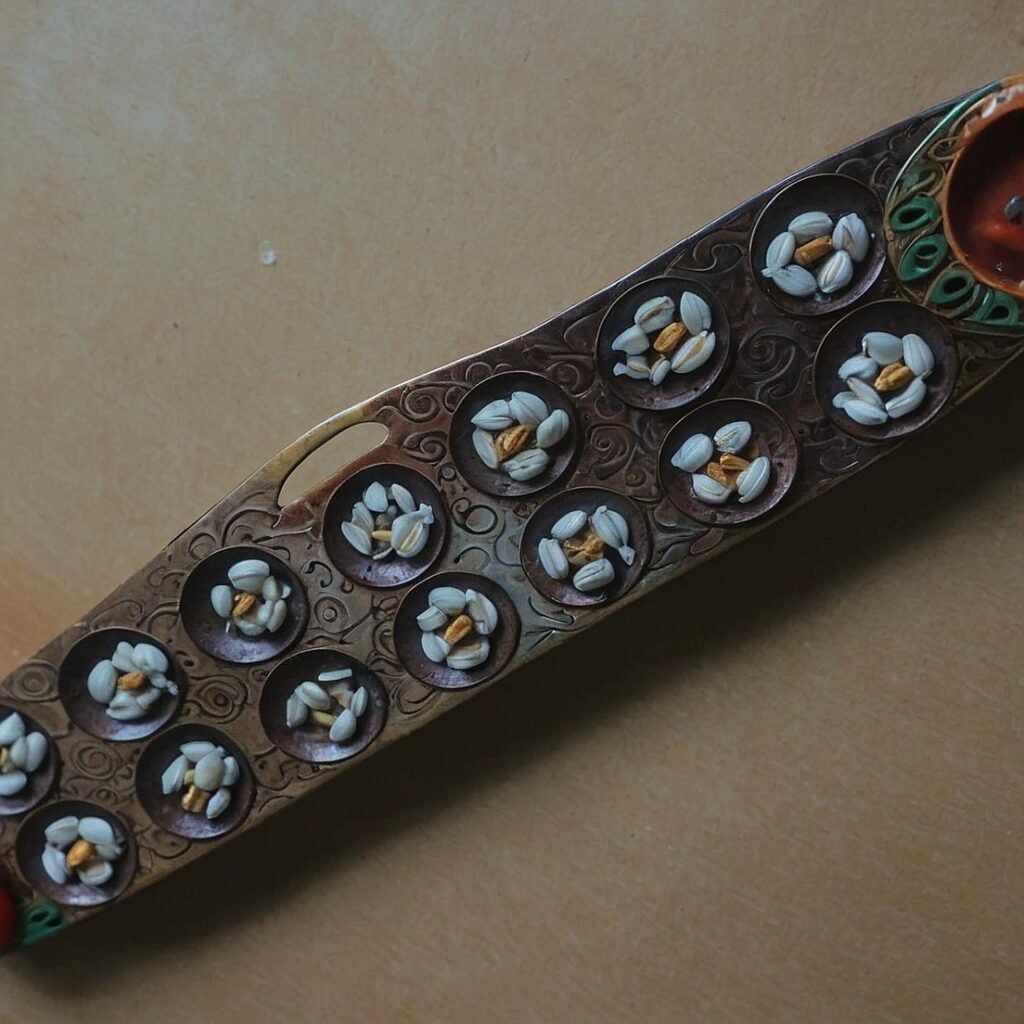Balik tanaw sa ating kabataan – looking back to our childhood. Do you remember the joyous sounds of laughter echoing through the streets of your barangay? The excited shouts of children playing under the warm Philippine sun? For many of us who grew up in the Philippines, these memories are inextricably linked to the traditional games that shaped our youth and connected us to generations past.
As I sit here in my Manila apartment, surrounded by the bustle of modern city life, I can’t help but feel a pang of nostalgia for those simpler times. The games we played weren’t just pastimes; they were windows into our cultural soul, teaching us valuable lessons about strategy, patience, and community spirit. Today, I invite you to join me on a journey through some of the most beloved traditional Filipino games, from the intricate Sungka to the energetic Piko, and explore how these games continue to be relevant in our fast-paced, digital world.
Sungka: The Game of Patience and Strategy
Let’s begin our journey with Sungka, a game that holds a special place in my heart. I can still vividly recall my lola’s weathered hands, moving shells with practiced grace across the wooden board. She would tell me, “Anak, this game is older than our oldest stories. It teaches us about life’s cycles and the importance of planning for the future.”
Sungka is played on a boat-shaped board with fourteen small pits, or “houses,” arranged in two rows of seven, and two larger pits, or “heads,” at each end. The game starts with seven shells or seeds in each of the fourteen smaller pits. Players take turns picking up all the shells from one of their houses and distributing them, one by one, counterclockwise around the board.
The objective is to capture as many shells as possible in your “head.” But here’s where the magic of Sungka lies – it’s not just about collecting shells. It’s about understanding the ebb and flow of resources, much like the cycles of planting and harvesting that have shaped Filipino agricultural communities for centuries.
As children, we didn’t realize we were learning valuable life lessons while playing. But looking back, I see how Sungka taught us patience, strategic thinking, and the importance of looking ahead. In a world where instant gratification is increasingly the norm, perhaps we could all benefit from sitting down to a game of Sungka, allowing its rhythmic play to remind us of the value of careful planning and patience.
Piko: Hopping Through History
From the quiet concentration of Sungka, let’s hop – quite literally – to the lively game of Piko. If you’ve ever walked through a Filipino neighborhood and seen chalk drawings on the pavement, chances are you’ve stumbled upon a Piko court.
Known by various names across the Philippines – such as “Pushing” in some Visayan regions or “Krus na Daan” in parts of Luzon – Piko is a game that has stood the test of time. Its simple requirements – a piece of chalk, a flat stone or pamato, and an open space – made it accessible to children from all walks of life.
The game involves drawing a pattern on the ground, usually in the shape of an airplane or a cross, with numbered sections. Players take turns throwing their pamato onto the numbered spaces and hopping through the course on one foot, avoiding the space where their stone landed. The goal is to complete the course without losing balance or stepping on any lines.
I remember countless afternoons spent playing Piko with my childhood friends in our small town in the Visayas. We would argue over whose turn it was, cheer each other on as we attempted difficult hops, and laugh uncontrollably when someone inevitably lost their balance and toppled over.
But Piko is more than just a test of balance and coordination. It’s a game that reflects the Filipino value of bayanihan – community spirit and cooperation. While players compete individually, the joy of the game comes from playing together, encouraging each other, and sharing in the collective experience.
In many ways, Piko mirrors the Filipino journey through life. We each have our own path to navigate, with obstacles to overcome and goals to reach. But we don’t walk this path alone. We’re surrounded by a community that cheers us on, picks us up when we fall, and celebrates our victories with us.
Tumbang Preso: The Game of Rebels and Guardians
As we move from the structured patterns of Piko, let’s turn our attention to a game that captures the Filipino spirit of rebellion and justice – Tumbang Preso. This game, whose name literally translates to “knock down the prisoner,” reflects our nation’s history of resistance against oppression and our enduring fight for freedom.
To play Tumbang Preso, you need an empty can (traditionally, it would have been a milk can) and slippers or rubber shoes. One player is designated as the “guard” who stands near the can, while the others are the “rebels” who try to knock down the can with their slippers from a distance.
If a rebel successfully knocks down the can, all players rush to retrieve their slippers while the guard tries to return the can to its original position. If the guard manages to do so before a player retrieves their slipper, that player becomes the new guard.
I remember playing this game in the dusty streets of our town, the excitement building as we aimed our tsinelas at the can. The thrill of successfully knocking it down, the mad dash to retrieve our slippers, and the groans of disappointment when caught – these memories are etched deeply in my mind.
But beyond the excitement, Tumbang Preso taught us important lessons about strategy, teamwork, and standing up against injustice. The “rebels” had to work together, distracting the guard and creating opportunities for each other. It instilled in us a sense of camaraderie and the importance of collective action in the face of challenges.
In many ways, Tumbang Preso is a metaphor for the Filipino people’s resilience and our history of resistance. Just as the players persistently try to knock down the can despite the guard’s efforts, our ancestors fought against colonizers and oppressors, never giving up in their pursuit of freedom and justice.
Patintero: The Art of Strategy and Agility
From the symbolic rebellion of Tumbang Preso, let’s move to a game that showcases the Filipino talent for strategy and quick thinking – Patintero. This game, also known as “Harangang Taga” or “Tubigan,” is a true test of agility, speed, and teamwork.
Patintero is played on a rectangular court divided into several squares. Two teams face off – one team tries to run from one end of the court to the other, while the defending team attempts to tag them by moving along the lines of the court. The attacking team wins if all members successfully cross to the other side, while the defending team wins if they manage to tag all the runners.
As a child growing up in the Visayas, Patintero was a staple of our summer vacations and after-school play. I can still feel the rush of adrenaline as I darted between defenders, trying to find a gap in their defenses. The shouts of encouragement from teammates, the triumphant cheers when someone made it across, and the good-natured teasing when caught – all these elements made Patintero more than just a game; it was a social event that brought the community together.
What fascinates me about Patintero is how it mirrors many aspects of Filipino culture and history. The game requires a delicate balance of individual skill and teamwork, much like how Filipino society values both personal achievement and community harmony. The strategy involved in Patintero – deciding when to run, how to create diversions, and how to coordinate with teammates – reflects the strategic thinking that has helped our people navigate challenges throughout history.
Moreover, Patintero teaches valuable life skills. It encourages quick decision-making, spatial awareness, and the ability to read and anticipate others’ movements. These skills, honed in childhood play, serve us well in navigating the complexities of adult life.
Luksong Tinik: Leaping Over Challenges
As we continue our journey through traditional Filipino games, let’s turn our attention to one that quite literally teaches us how to overcome obstacles – Luksong Tinik. This game, whose name translates to “jumping over thorns,” is a test of physical prowess and courage.
Luksong Tinik is played by two teams. Two players from one team sit on the ground, feet soles touching, with their hands clasped together and resting on their feet. This formation represents the “thorns” or “tinik.” Players from the other team must jump over this human obstacle without touching it. As the game progresses, the “thorns” are raised higher and higher, making the jumps increasingly challenging.
I remember playing Luksong Tinik in our town plaza, surrounded by cheering friends and curious onlookers. The mix of excitement and trepidation as we faced increasingly difficult jumps, the satisfaction of clearing a high “tinik,” and the laughter that ensued when someone inevitably crashed into the human obstacle – these memories are a treasured part of my childhood.
But Luksong Tinik is more than just a physical challenge. It’s a metaphor for life’s obstacles and our ability to overcome them. Each jump represents a hurdle we face, and with each successful leap, we grow more confident in our abilities to face future challenges.
The game also teaches important values. It requires trust – both in oneself to make the jump and in one’s teammates who form the “tinik.” It instills courage, pushing players to attempt jumps that seem daunting. And it fosters resilience, encouraging players to try again after a failed attempt.
In many ways, Luksong Tinik embodies the Filipino spirit of resilience and determination. Just as we leap over the “thorns” in the game, our people have shown an remarkable ability to rise above challenges, whether they be natural disasters, economic hardships, or social issues.
Sipa: The Pride of Filipino Sportsmanship
No discussion of traditional Filipino games would be complete without mentioning Sipa, often considered our national sport before basketball took center stage. Sipa, which simply means “kick” in Tagalog, is a game that showcases the incredible foot dexterity of Filipino players.
The game is played with a small rattan ball called the sipa. Players form a circle and take turns keeping the ball in the air using only their feet, knees, and other parts of the body excluding the arms and hands. The objective is to keep the sipa aloft for as long as possible, with players counting the number of successful kicks.
As a child, I was always in awe of the older kids who could keep the sipa bouncing seemingly effortlessly, their feet moving in a blur of precise kicks. It took me countless hours of practice to even manage a few consecutive kicks, but the joy of improvement and the camaraderie of playing with friends made every scraped knee and stubbed toe worth it.
Sipa is more than just a game of skill; it’s a cultural icon that represents Filipino ingenuity and resourcefulness. The sipa itself, traditionally made from rattan, exemplifies how our ancestors created enjoyment from simple, readily available materials. The game’s rules, which evolved over time and vary from region to region, show the adaptability of Filipino culture.
Moreover, Sipa embodies important values in Filipino society. It teaches patience and perseverance – skills aren’t developed overnight, but through consistent practice. It fosters sportsmanship, as players encourage each other and celebrate collective achievements. And it promotes physical fitness in a fun, engaging way.
In recent years, there have been efforts to revive interest in Sipa, with some schools incorporating it into their physical education programs. This resurgence is not just about preserving a game; it’s about maintaining a connection to our cultural heritage and the values it represents.
The Relevance of Traditional Games in Modern Philippines
As we’ve journeyed through these beloved traditional games, you might wonder: in an age of smartphones, video games, and endless digital entertainment, do these games still have a place in modern Filipino society?
I believe the answer is a resounding yes. These games are more than just pastimes; they are living pieces of our heritage, carriers of values and life lessons that remain relevant today. In a world where screen time often replaces face-to-face interaction, traditional games offer a way to build real-world connections and foster a sense of community.
Moreover, many of these games provide physical activity in a fun, engaging way – a crucial consideration in addressing the growing issue of childhood obesity. They develop motor skills, strategic thinking, and social skills in ways that digital games often can’t match.
But perhaps most importantly, these games serve as a bridge between generations. When a lola teaches her apo how to play sungka, or when parents join their children in a game of patintero, they’re not just playing – they’re passing down cultural knowledge, strengthening family bonds, and creating shared memories that will be treasured for years to come.
Preserving Our Gaming Heritage
As a cultural heritage writer, I’ve made it my mission to document and share these games with a wider audience. Through my work with museums, educational blogs, and cultural magazines, I strive to ensure that the rules, history, and cultural significance of these games are not lost to time.
But preservation isn’t just about documentation – it’s about keeping these games alive in practice. I encourage parents and educators to introduce these games to children. Consider organizing traditional game days in your community or school. Incorporate elements of these games into modern fitness routines or team-building exercises.
For those of us in the Filipino diaspora, these games can serve as a powerful connection to our roots. Teaching our children to play sungka or patintero isn’t just about fun – it’s about passing on a piece of their cultural identity.
The Timeless Appeal of Traditional Filipino Games
From the strategic depths of Sungka to the physical challenges of Luksong Tinik, from the teamwork required in Patintero to the individual skill showcased in Sipa, traditional Filipino games offer a rich tapestry of experiences. They are windows into our past, mirrors of our values, and bridges to our future.
As we navigate the complexities of the modern world, let’s not forget the simple joys and profound lessons these games offer. They remind us of the importance of face-to-face interaction, physical activity, and community spirit. They teach us valuable skills and embody cherished values. Most of all, they connect us – to each other, to our culture, and to the generations that came before us.
So the next time you see children playing Piko on the sidewalk, or hear the familiar shouts of a Patintero game, take a moment to appreciate the living history before you. Better yet, why not join in? After all, in the world of traditional Filipino games, there’s always room for one more player.
As we say in Filipino, “Ang laro ay buhay, at ang buhay ay laro” – Play is life, and life is play. In the simple act of playing these traditional games, we celebrate our heritage, strengthen our communities, and keep alive a vital part of what it means to be Filipino. So let’s play on, passing these games from generation to generation, ensuring that the laughter and lessons of our childhood games continue to echo through the years.




